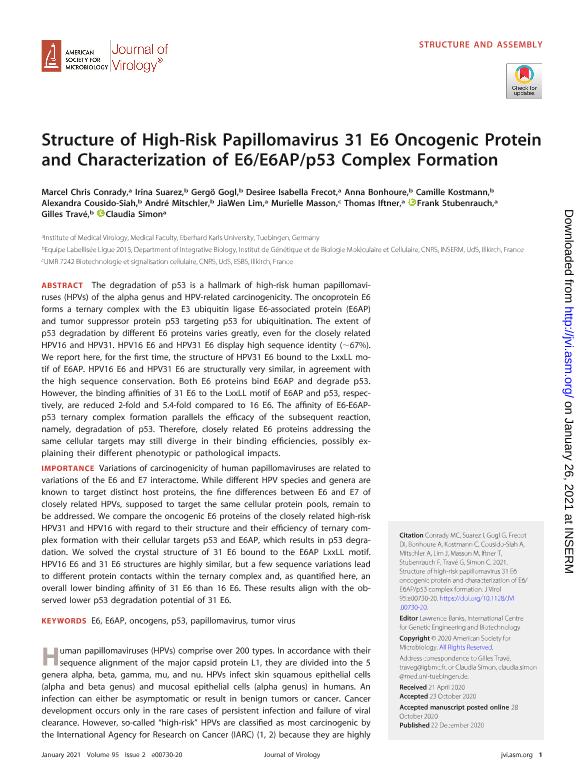Mostrar el registro sencillo del ítem
dc.contributor.author
Conrady, Marcel Chris
dc.contributor.author
Suarez, Irina Paula

dc.contributor.author
Gogl, Gergö
dc.contributor.author
Frecot, Desiree Isabella
dc.contributor.author
Bonhoure, Anna
dc.contributor.author
Kostmann, Camille
dc.contributor.author
Cousido Siah, Alexandra
dc.contributor.author
Mitschler, André
dc.contributor.author
Lim, JiaWen
dc.contributor.author
Masson, Murielle
dc.contributor.author
Iftner, Thomas
dc.contributor.author
Stubenrauch, Frank
dc.contributor.author
Travé, Gilles
dc.contributor.author
Simon, Claudia

dc.date.available
2023-09-13T15:40:37Z
dc.date.issued
2021-01
dc.identifier.citation
Conrady, Marcel Chris; Suarez, Irina Paula; Gogl, Gergö; Frecot, Desiree Isabella; Bonhoure, Anna; et al.; Structure of high-risk papillomavirus 31 E6 oncogenic protein and characterization of E6/E6AP/p53 complex formation; American Society for Microbiology; Journal of Virology; 95; 2; 1-2021; 1-15
dc.identifier.issn
0022-538X
dc.identifier.uri
http://hdl.handle.net/11336/211398
dc.description.abstract
The degradation of p53 is a hallmark of high-risk human papillomaviruses (HPVs) of the alpha genus and HPV-related carcinogenicity. The oncoprotein E6 forms a ternary complex with the E3 ubiquitin ligase E6-associated protein (E6AP) and tumor suppressor protein p53 targeting p53 for ubiquitination. The extent of p53 degradation by different E6 proteins varies greatly, even for the closely related HPV16 and HPV31. HPV16 E6 and HPV31 E6 display high sequence identity (~67%). We report here, for the first time, the structure of HPV31 E6 bound to the LxxLL motif of E6AP. HPV16 E6 and HPV31 E6 are structurally very similar, in agreement with the high sequence conservation. Both E6 proteins bind E6AP and degrade p53. However, the binding affinities of 31 E6 to the LxxLL motif of E6AP and p53, respectively, are reduced 2-fold and 5.4-fold compared to 16 E6. The affinity of E6-E6APp53 ternary complex formation parallels the efficacy of the subsequent reaction, namely, degradation of p53. Therefore, closely related E6 proteins addressing the same cellular targets may still diverge in their binding efficiencies, possibly explaining their different phenotypic or pathological impacts. IMPORTANCE Variations of carcinogenicity of human papillomaviruses are related to variations of the E6 and E7 interactome. While different HPV species and genera are known to target distinct host proteins, the fine differences between E6 and E7 of closely related HPVs, supposed to target the same cellular protein pools, remain to be addressed. We compare the oncogenic E6 proteins of the closely related high-risk HPV31 and HPV16 with regard to their structure and their efficiency of ternary complex formation with their cellular targets p53 and E6AP, which results in p53 degradation. We solved the crystal structure of 31 E6 bound to the E6AP LxxLL motif. HPV16 E6 and 31 E6 structures are highly similar, but a few sequence variations lead to different protein contacts within the ternary complex and, as quantified here, an overall lower binding affinity of 31 E6 than 16 E6. These results align with the observed lower p53 degradation potential of 31 E6.
dc.format
application/pdf
dc.language.iso
eng
dc.publisher
American Society for Microbiology

dc.rights
info:eu-repo/semantics/openAccess
dc.rights.uri
https://creativecommons.org/licenses/by-nc-sa/2.5/ar/
dc.subject
E6
dc.subject
E6AP
dc.subject
ONCOGENS
dc.subject
P53
dc.subject
PAPILLOMAVIRUS
dc.subject
TUMOR VIRUS
dc.subject.classification
Biofísica

dc.subject.classification
Ciencias Biológicas

dc.subject.classification
CIENCIAS NATURALES Y EXACTAS

dc.title
Structure of high-risk papillomavirus 31 E6 oncogenic protein and characterization of E6/E6AP/p53 complex formation
dc.type
info:eu-repo/semantics/article
dc.type
info:ar-repo/semantics/artículo
dc.type
info:eu-repo/semantics/publishedVersion
dc.date.updated
2023-09-13T11:54:04Z
dc.journal.volume
95
dc.journal.number
2
dc.journal.pagination
1-15
dc.journal.pais
Estados Unidos

dc.journal.ciudad
Washington
dc.description.fil
Fil: Conrady, Marcel Chris. Eberhard Karls Universität Tübingen; Alemania
dc.description.fil
Fil: Suarez, Irina Paula. Centre National de la Recherche Scientifique; Francia. Consejo Nacional de Investigaciones Científicas y Técnicas. Centro Científico Tecnológico Conicet - Rosario. Instituto de Biología Molecular y Celular de Rosario. Universidad Nacional de Rosario. Facultad de Ciencias Bioquímicas y Farmacéuticas. Instituto de Biología Molecular y Celular de Rosario; Argentina
dc.description.fil
Fil: Gogl, Gergö. Centre National de la Recherche Scientifique; Francia
dc.description.fil
Fil: Frecot, Desiree Isabella. Eberhard Karls Universität Tübingen; Alemania
dc.description.fil
Fil: Bonhoure, Anna. Centre National de la Recherche Scientifique; Francia
dc.description.fil
Fil: Kostmann, Camille. Centre National de la Recherche Scientifique; Francia
dc.description.fil
Fil: Cousido Siah, Alexandra. Centre National de la Recherche Scientifique; Francia
dc.description.fil
Fil: Mitschler, André. Centre National de la Recherche Scientifique; Francia
dc.description.fil
Fil: Lim, JiaWen. Eberhard Karls Universität Tübingen; Alemania
dc.description.fil
Fil: Masson, Murielle. No especifíca;
dc.description.fil
Fil: Iftner, Thomas. Eberhard Karls Universität Tübingen; Alemania
dc.description.fil
Fil: Stubenrauch, Frank. Eberhard Karls Universität Tübingen; Alemania
dc.description.fil
Fil: Travé, Gilles. Centre National de la Recherche Scientifique; Francia
dc.description.fil
Fil: Simon, Claudia. Eberhard Karls Universität Tübingen; Alemania
dc.journal.title
Journal of Virology

dc.relation.alternativeid
info:eu-repo/semantics/altIdentifier/doi/http://dx.doi.org/10.1128/JVI.00730-20
Archivos asociados
